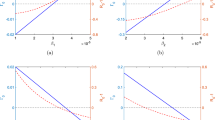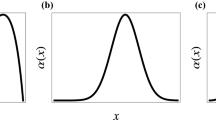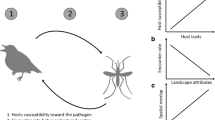Abstract
Empirical observations and mathematical models show that climate warming can lead to the northern (or, more generally, poleward) spread of host species ranges and their corresponding diseases. Here, we consider an unexpected possibility whereby climate warming facilitates disease spread in the opposite direction to the directional shift in the host species range. To explore this possibility, we consider two host species, both susceptible to a disease, but spatially isolated due to distinct thermal niches, and where prior to climate warming the disease is endemic in the northern species only. Previous theoretical results show that species distributions can lag behind species thermal niches when climate warming occurs. As such, we hypothesize that climate warming may increase the overlap between northern and southern host species ranges, due to the northern species lagging behind its thermal tolerance limit. To test our hypothesis, we simulate climate warming as a reaction-diffusion equation model with a Susceptible-Infected (SI) epidemiological structure, for two competing species with distinct temperature-dependent niches. We show that climate warming, by shifting both species niches northwards, can facilitate the southward spread of disease, due to increased range overlap between the two populations. As our model is general, our findings may apply to viral, bacterial, and prion diseases that do not have thermal tolerance limits and are inextricably linked to their hosts distributions, such as the spread of rabies from arctic to red foxes.



Similar content being viewed by others
References
Amarasekare P, Savage V (2012) A framework for elucidating the temperature dependence of fitness. Am Nat 179(2):178–191
Barton MG, Clusella-Trullas S, Terblanche JS (2019) Spatial scale, topography and thermoregulatory behaviour interact when modelling species thermal niches. Ecography 42(2):376–389
Bellard C, Thuiller W, Leroy B, Genovesi P, Bakkenes M, Courchamp F (2013) Will climate change promote future invasions? Glob Change Biol 19(12):3740–3748
Berestycki H, Diekmann O, Nagelkerke CJ, Zegeling PA (2009) Can a species keep pace with a shifting climate? Bull Math Biol 71(2):399
Brownstein JS, Holford TR, Fish D (2005) Effect of climate change on lyme disease risk in north america. EcoHealth 2(1):38–46
Cantrell RS, Cosner C (2004) Spatial ecology via reaction-diffusion equations. John Wiley & Sons
Finnegan CJ, Brookes SM, Johnson N, Smith J, Mansfield KL, Keene VL, McElhinney LM, Fooks AR (2002) Rabies in North America and Europe. J R Soc Med 95(1):9–13
Gallant D, Slough BG, Reid DG, Berteaux D (2012) Arctic fox versus red fox in the warming Arctic: four decades of den surveys in north Yukon. Polar Biol 35(9):1421–1431
Gallant D, Lecomte N, Berteaux D (2020) Disentangling the relative influences of global drivers of change in biodiversity: A study of the twentieth-century red fox expansion into the Canadian Arctic. J Anim Ecol 89(2):565–576
Georgsson G, Sigurdarson S, Brown P (2006) Infectious agent of sheep scrapie may persist in the environment for at least 16 years. J Gen Virol 87(12):3737–3740
Gibert JP, Chelini MC, Rosenthal MF, DeLong JP (2016) Crossing regimes of temperature dependence in animal movement. Glob Change Biol 22(5):1722–1736
Hales S, De Wet N, Maindonald J, Woodward A (2002) Potential effect of population and climate changes on global distribution of dengue fever: an empirical model. The Lancet 360(9336):830–834
Harsch MA, Zhou Y, HilleRisLambers J, Kot M (2014) Keeping pace with climate change: stage-structured moving-habitat models. Am Nat 184(1):25–37
Hoffmann M, Sillero-Zubiri C (2021) Vulpes vulpes (amended version of 2016 assessment). The IUCN Red List of Threatened Species
Hurford A, Cobbold CA, Molnár PK (2019) Skewed temperature dependence affects range and abundance in a warming world. Proc R Soc B 286(1908):20191157
Joly DO, Messier F (2005) The effect of bovine tuberculosis and brucellosis on reproduction and survival of wood bison in Wood Buffalo National Park. J Anim Ecol pp 543–551
Kenna D, Pawar S, Gill RJ (2021) Thermal flight performance reveals impact of warming on bumblebee foraging potential. Funct Ecol 35(11):2508–2522
Kura K, Khamis D, El Mouden C, Bonsall MB (2019) Optimal control for disease vector management in SIT models: an integrodifference equation approach. J Math Biol 78(6):1821–1839
Leung MR, Kot M (2015) Models for the spread of white pine blister rust. J Theor Biol 382:328–336
Lubitz N, Bradley M, Sheaves M, Hammerschlag N, Daly R, Barnett A (2022) The role of context in elucidating drivers of animal movement. Ecol Evol 12(7):e9128
MacDonald JS, Bourgault Y, Lutscher F (2021) Moving-habitat models: A numerical approach. Math Biosci 341:108711
Martens W, Niessen LW, Rotmans J, Jetten TH, McMichael AJ (1995) Potential impact of global climate change on malaria risk. Environ Health Perspect 103(5):458–464
Massolo A, Liccioli S, Budke C, Klein C (2014) Echinococcus multilocularis in North America: the great unknown. Parasite 21
Menéndez R, Megías AG, Hill JK, Braschler B, Willis SG, Collingham Y, Fox R, Roy DB, Thomas CD (2006) Species richness changes lag behind climate change. Proc R Soc B Biol Sci 273(1593):1465–1470
Miller MW, Williams ES, Hobbs NT, Wolfe LL (2004) Environmental sources of prion transmission in mule deer. Emerg Infect Dis 10(6):1003
Mørk T, Prestrud P (2004) Arctic rabies-a review. Acta Vet Scand 45(1):1–9
Nishi JS, Shury T, Elkin BT (2006) Wildlife reservoirs for bovine tuberculosis (Mycobacterium bovis) in Canada: strategies for management and research. Vet Microbiol 112(2–4):325–338
Pachauri RK, Allen MR, Barros VR, Broome J, Cramer W, Christ R, Church JA, Clarke L, Dahe Q, Dasgupta P et al (2014) Climate change 2014: synthesis report. Contribution of Working Groups I, II and III to the fifth assessment report of the Intergovernmental Panel on Climate Change. Ipcc
Paradis A, Elkinton J, Hayhoe K, Buonaccorsi J (2008) Role of winter temperature and climate change on the survival and future range expansion of the hemlock woolly adelgid (Adelges tsugae) in Eastern North America. Mitig Adapt Strat Glob Change 13(5):541–554
Patz JA, Epstein PR, Burke TA, Balbus JM (1996) Global climate change and emerging infectious diseases. JAMA 275(3):217–223
Potapov AB, Lewis MA (2004) Climate and competition: the effect of moving range boundaries on habitat invasibility. Bull Math Biol 66(5):975–1008
Pounds JA (2001) Climate and amphibian declines. Nature 410(6829):639–640
Purse BV, Mellor PS, Rogers DJ, Samuel AR, Mertens PP, Baylis M (2005) Climate change and the recent emergence of bluetongue in europe. Nat Rev Microbiol 3(2):171–181
Savory G, Hunter C, Wooller M, O’Brien D (2014) Anthropogenic food use and diet overlap between red foxes (Vulpes vulpes) and arctic foxes (Vulpes lagopus) in Prudhoe Bay Alaska. Can J Zool 92(8):657–663
Short EE, Caminade C, Thomas BN (2017) Climate change contribution to the emergence or re-emergence of parasitic diseases. Infectious Diseases: Research and Treatment 10:1178633617732296
Simon A, Tardy O, Hurford A, Lecomte N, Bélanger D, Leighton P (2019) Dynamics and persistence of rabies in the Arctic. Polar Res
Stephanson CA, Ribarik Coe N (2017) Impacts of beech bark disease and climate change on American beech. Forests 8(5):155
Sutherland GD, Harestad AS, Price K, Lertzman KP (2000) Scaling of natal dispersal distances in terrestrial birds and mammals. Conserv Ecol 4(1)
Tabel H, Corner A, Webster W, Casey C (1974) History and epizootiology of rabies in Canada. Can Vet J 15(10):271
Talluto MV, Boulangeat I, Vissault S, Thuiller W, Gravel D (2017) Extinction debt and colonization credit delay range shifts of eastern north american trees. Nature Ecology & Evolution 1(7):1–6
Tannerfeldt M, Elmhagen B, Angerbjörn A (2002) Exclusion by interference competition? The relationship between red and arctic foxes. Oecologia 132(2):213–220
Veit P, Bilger B, Schad V, Schäfer J, Frank W, Lucius R (1995) Influence of environmental factors on the infectivity of Echinococcus multilocularis eggs. Parasitology 110(1):79–86
Zhou Y, Kot M (2011) Discrete-time growth-dispersal models with shifting species ranges. Thyroid Res 4(1):13–25
Funding
AH, PL and NL were supported by the National Sciences and Engineering Research Council (NSERC) Discovery Grant (AH: 2014-05413; PL: 2014-03793; NL: 2014-03043). AH and PL were supported by the One Health Modelling Network for Emerging Infections (OMNI). AH was supported by the Emerging Infectious Disease Modelling Consortium. NL was supported by the Canada Research Chair Program, by the Canadian Innovation Fund, and by the Université de Moncton.
Author information
Authors and Affiliations
Contributions
MM and EJM wrote the manuscript. MM wrote the code and completed the analysis, building on earlier code and analysis by EJM. PL, NL and AH motivated the research question and revised the manuscript. AH, MM, and EJM conceived of the analysis.
Corresponding author
Ethics declarations
Conflict of interest
The authors declare no competing interests.
Additional information
Publisher’s Note
Springer Nature remains neutral with regard to jurisdictional claims in published maps and institutional affiliations.
Open research statement The computer code used for the simulations is novel and available at https://figshare.com/s/60caec76973c3da640d0.
Supplementary Information
Below is the link to the electronic supplementary material.
Rights and permissions
Springer Nature or its licensor (e.g. a society or other partner) holds exclusive rights to this article under a publishing agreement with the author(s) or other rightsholder(s); author self-archiving of the accepted manuscript version of this article is solely governed by the terms of such publishing agreement and applicable law.
About this article
Cite this article
Moran, E.J., Martignoni, M.M., Lecomte, N. et al. When host populations move north, but disease moves south: Counter-intuitive impacts of climate change on disease spread. Theor Ecol 16, 13–19 (2023). https://doi.org/10.1007/s12080-022-00551-z
Received:
Accepted:
Published:
Issue Date:
DOI: https://doi.org/10.1007/s12080-022-00551-z




